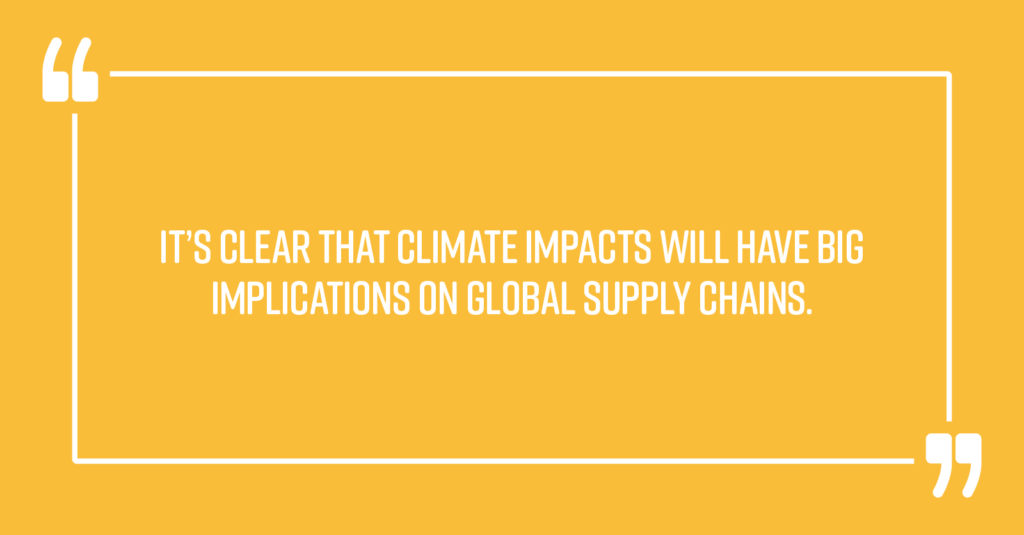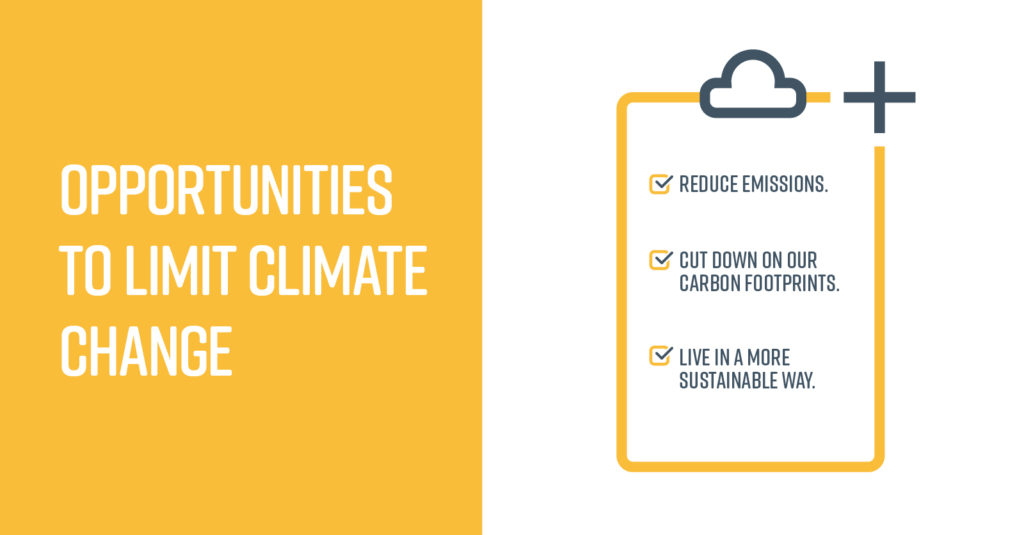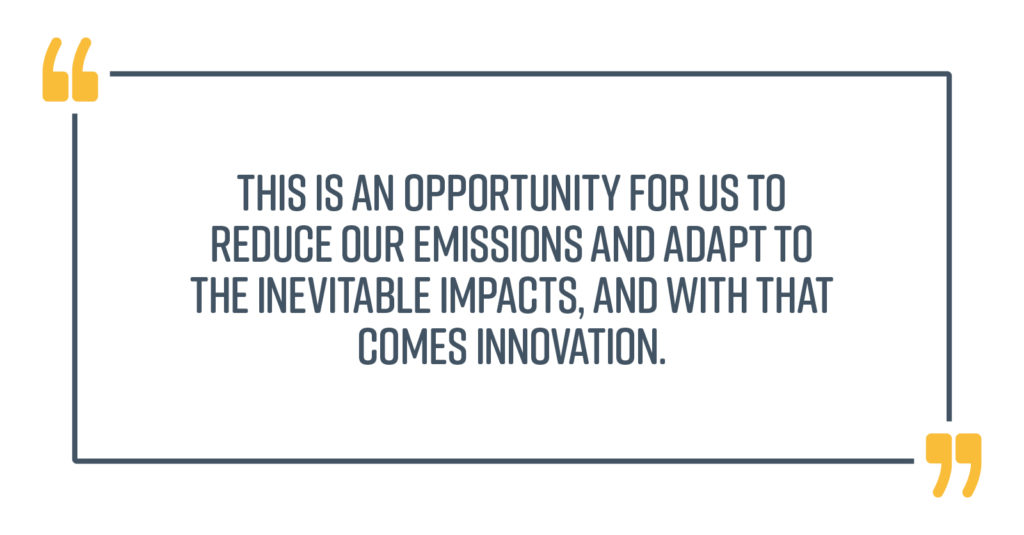Dr Deborah Hemming, of the Met Office, explores climate change and its likely impact on procurement and supply functions. This includes the effects on food supply, the underdeveloped world, farming, and how technology and people can adapt to the future.
Climate change is a huge topic. But what does it mean for our future supply chains?
Recent reports by the Intergovernmental Panel on Climate Change (IPCC) have shown – unequivocally – that human influence has warmed the global climate and that every region of the world is being impacted.
This comes as no surprise. We’ve already observed sea ice reduction, glacier retreat and greening of some of the colder northern and mountain regions – all clear evidence of global warming. And we’re also experiencing some extreme events likely to be influenced by this, such as heatwaves, floods and droughts. Human-induced greenhouse gas emissions and land use changes are the key drivers behind these changes.
We can expect even more accentuated impacts. We might be looking at more extreme negative occurrences across the globe. Of course, some areas will be more at risk than others. Colder ones might enjoy warmer and longer growing seasons and others may become too hot to manage with our current technologies and lifestyles.
Impacts on global supply chains
It’s clear that climate impacts will have big implications on global supply chains.
Around the globe, we’ll start to see more unprecedented, extreme events as the general trend of warming continues to rise.
Our infrastructure and machinery are not built to be resilient to these unprecedented extremes in temperature, rainfall, river flow or wind speed. Combinations of these factors may cause problems that are difficult to anticipate. Consequently, it will be difficult to adapt using current technology, such as cooling and refrigerating systems. These may prove inadequate and cause issues with products that need to be stored in cool conditions, particularly if they come from warmer regions.
Obviously, agriculture is very weather dependent. Climatic events could cause large losses in the major breadbasket regions of the world, so called because of their abundance of fertile land. This would have significant impacts on the security of our food supply chains.
Within these regions, pests and diseases are also likely to spread and change in their population dynamics as, when climate alters, so does its suitability for species. We could see new outbreaks that completely devastate crops.
Globalization and the increasing trade and movement of people and goods and services mean there are more opportunities for pests to spread. Imported products may contain eggs that then become endemic in that country. This is a major route by which new pests and pathogens and diseases arrive.

The developing world
Sadly, many of the poorest nations who have contributed the least in terms of greenhouse gas emissions, are expected to suffer the most serious impacts from climate change. Some of these are already struggling to provide enough food for their populations. And, during recent climate events, there’s been little capacity to adapt.
Having said that, indigenous people in these areas have developed effective ways to be resilient to variability and change in weather and climate. Perhaps more should be done to boost these practices and build economic and agricultural capacity in these regions.
Securing supply
Consumers will continue to seek a wide range of food products. There is more awareness of where food comes from, how it’s grown and the conditions and chemicals used to produce it. There is also an increasing demand for more healthy and sustainable food products. These trends seem likely to continue and we may see more demand for food that’s grown sustainably and locally.
There is certainly more of an emphasis on local production. Climate changes are also affecting the suitability of different areas for different crops and species. And so this will alter the mix of food that’s produced in different regions. For example, we may see more vineyards emerging in the UK.
Of course, there is always a drive for increasing quality and production. But there is also an emphasis on sustainable and healthy food with less chemical addition and a move to less intensive agricultural systems. There is great interest now in agro-forestry that combines forestry with crop and livestock farming, such as orchards with poultry farming. The combination of solar panels and animal pasture is already used widely. These kinds of systems are likely to become more prevalent.
Adaptation and innovation

Already parts of the earth are not inhabited because of extreme climates. But there will be regions that become more pressured by warming and sea level rise as well as coastal regions that will be impractical to maintain.
Other areas will become basically uninhabitable with our current technologies. But technologies change and we are very good at adapting to changes and variability.
We will need to think of clever ways to anticipate and adapt to changes. And the more we understand about how they are likely to occur and the potential extremes of these in different regions, the more these will be factored into new building design, for example, new infrastructure projects.
At the moment, much of our technology and infrastructure is based on what the climate was like over the last 30 or 40 years and the kind of extremes in climate that we experienced at the time. Going into the future, I think if we can factor in a more forward looking view of what the climate will be like in 30, 40, 50 years’ + time, then we are likely to be able to adapt to these future changes. But there will be extreme and very challenging conditions. So, we really do need to reduce our emissions, cut down on our carbon footprints and live in a more sustainable way into the future. And this will make all our lives easier. Although such fundamental changes can be daunting, the sooner we change the more chance we have of limiting the most damaging impacts.
This is an opportunity for us to reduce our emissions and adapt to the inevitable impacts, and with that comes innovation. We’re a very ingenious species. And we’ve seen throughout history that we are able to respond to many challenges by innovating.

Opportunities
In current times, I would see agri-forestry as a new upcoming industry, and the emergence of smaller scale production, particularly of food and energy, local sustainable options and more recycling and re-use of products. Industries will grow from these trends.
Another likely area of growth in the UK is within industries that help people and communities to adapt to climate change, such as in flooded areas. In countries, including the Netherlands, houses are constructed on stilts or they can float up and down. These kinds of innovative ideas are likely to grow in the future.
What can we do?
Industries are factoring in the current science of climate and future climate projections, and the uncertainties involved, in their risk assessment steps, for example, in procurement.
We, as people, organizations and governments need to be flexible, innovative and prepared for likely future changes.
From a procurement perspective, we need to try and understand what the organization is doing about sustainability and support efforts to reduce impact on the climate.
From a personal perspective, if there’s one thing we can do today that will make a better tomorrow, consider joining a local wildlife trust. There you can help with the projects that will not only make a difference to your local area but will also make you feel good.
Dr Deborah Hemming has been working on the science of climate change at the Met Office in the UK for 17 years. Debbie has an MSC in applied meteorology, a PhD in plant science from Cambridge University and is Scientific Manager of the Vegetation-Climate Interactions (VCI) group which conducts research to improve understanding and modelling of the interactions between vegetation and climate.

